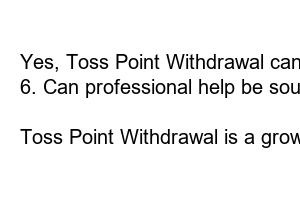토스 포인트 출금
Title: Say Goodbye to Toss Point Withdrawal: A Guide to Easing Digital Dependence
Subheadings:
1. Introduction: The Rise of Toss Point Withdrawal
2. Understanding Toss Point Withdrawal: Symptoms and Effects
3. Withdrawal Management: Tips and Techniques for Recovery
4. Unplug and Reconnect: Rediscover Real-Life Interactions
5. Mastering Mindfulness: The Power of Being Present
6. Establishing Healthy Tech Habits: Striking a Balance
7. FAQs: Addressing Concerns About Toss Point Withdrawal
Introduction: The Rise of Toss Point Withdrawal
In today’s fast-paced digital world, it’s not surprising that many of us are experiencing a phenomenon known as Toss Point Withdrawal. This newfound condition occurs when individuals are separated from their smartphones, laptops, and other digital devices, leading to feelings of restlessness and anxiety. In this blog post, we will explore the symptoms, effects, and strategies to manage Toss Point Withdrawal for a more balanced and fulfilling life.
Understanding Toss Point Withdrawal: Symptoms and Effects
Toss Point Withdrawal manifests in various ways, including intensified stress levels, irritability, disrupted sleep patterns, difficulty concentrating, and a constant urge to check one’s phone or digital gadgets. The effects can negatively impact personal relationships, work productivity, and overall well-being. It’s essential to address these symptoms to prevent them from spiraling out of control.
Withdrawal Management: Tips and Techniques for Recovery
To kickstart your journey towards overcoming Toss Point Withdrawal, it’s crucial to set realistic goals, gradually decrease screen time, and engage in activities that provide healthier alternatives to digital dependency. **Integrating regular exercise** into your routine can immensely help in reducing stress and anxiety, while **practicing deep breathing exercises** can promote relaxation and self-awareness.
Unplug and Reconnect: Rediscover Real-Life Interactions
One of the key components of combating Toss Point Withdrawal is to **reconnect with face-to-face interactions**. Make a conscious effort to spend quality time with friends and family, engaging in activities that foster meaningful conversations and genuine connections. **Organize regular digital detox days** to fully immerse yourself in offline experiences, whether it’s exploring nature, reading a book, or pursuing a new hobby.
Mastering Mindfulness: The Power of Being Present
Mindfulness can be a powerful tool in alleviating Toss Point Withdrawal symptoms. By focusing on the present moment, you can cultivate a sense of calmness and regain control over your thoughts and actions. **Practice mindfulness techniques** such as meditation, journaling, or simply taking a few minutes each day to observe your surroundings without distractions.
Establishing Healthy Tech Habits: Striking a Balance
Creating healthy tech habits is essential to prevent Toss Point Withdrawal from recurring. Establish a designated time for checking emails and social media to avoid mindless scrolling. **Implementing digital boundaries**, such as switching off notifications during certain periods, can help you regain control over your screen time and prioritize meaningful offline experiences.
FAQs: Addressing Concerns About Toss Point Withdrawal
1. Can Toss Point Withdrawal be classified as an addiction?
No, Toss Point Withdrawal is not considered a clinical addiction. However, it is crucial to address the symptoms and find a healthy balance with digital devices.
2. How long does it take to overcome Toss Point Withdrawal?
The recovery process varies for each individual. It may take a few weeks or months to fully overcome Toss Point Withdrawal, depending on the severity of the symptoms and the efforts put into implementing healthier habits.
3. Is completely disconnecting from digital devices necessary?
Completely disconnecting from digital devices may not be feasible for everyone. The goal is to establish a healthy balance, where digital devices serve as tools rather than sources of constant distraction and dependence.
4. How can I resist the urge to constantly check my phone?
Try implementing tactics such as keeping your phone out of reach during certain times, practicing mindful breathing before reaching for your phone, or using apps that track and limit screen time.
5. Can Toss Point Withdrawal affect work productivity?
Yes, Toss Point Withdrawal can significantly impact work productivity due to increased distractions and difficulty concentrating. However, by implementing strategies mentioned previously, you can regain focus and improve efficiency.
6. Can professional help be sought to manage Toss Point Withdrawal?
If the symptoms of Toss Point Withdrawal become debilitating or interfere with daily life, it may be beneficial to consult a mental health professional who can provide guidance and support in managing the condition.
Summary:
Toss Point Withdrawal is a growing concern in our technology-driven society, but it’s not insurmountable. By understanding the symptoms, effects, and implementing effective strategies like reducing screen time, reconnecting with others, and practicing mindfulness, you can regain control over your digital habits and achieve a healthier and more balanced life. Remember, moderation and self-awareness are key to overcoming Toss Point Withdrawal and embracing a fulfilling offline existence.

